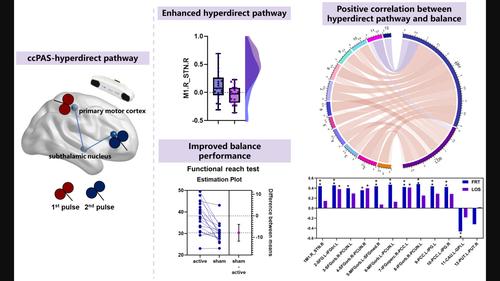当前位置:
X-MOL 学术
›
CNS Neurosci. Ther.
›
论文详情
Our official English website, www.x-mol.net, welcomes your feedback! (Note: you will need to create a separate account there.)
The promotion‐like effect of the M1‐STN hyperdirect pathway induced by ccPAS enhanced balance performances: From the perspective of brain connectivity
CNS Neuroscience & Therapeutics ( IF 5.5 ) Pub Date : 2024-04-14 , DOI: 10.1111/cns.14710 Yu‐Lin Li 1, 2 , Jia‐Jia Wu 3 , Xu‐Yun Hua 4 , Mou‐Xiong Zheng 4 , Jian‐Guang Xu 1, 3, 5
CNS Neuroscience & Therapeutics ( IF 5.5 ) Pub Date : 2024-04-14 , DOI: 10.1111/cns.14710 Yu‐Lin Li 1, 2 , Jia‐Jia Wu 3 , Xu‐Yun Hua 4 , Mou‐Xiong Zheng 4 , Jian‐Guang Xu 1, 3, 5
Affiliation

|
AimsThe present study aimed to explore the effect of cortico‐cortical paired‐associative stimulation (ccPAS) in modulating hyperdirect pathway and its influence on balance performance.MethodsForty healthy participants were randomly allocated to the active ccPAS group (n = 20) or the sham ccPAS group (n = 20). The primary motor cortex and subthalamic nucleus were stimulated sequentially with ccPAS. Unlike the active ccPAS group, one wing of coil was tilted to form a 90° angle with scalp of stimulation locations for the sham ccPAS group. Magnetic resonance imaging, functional reach test (FRT), timed up and go (TUG) test, and limit of stability (LOS) test were performed, and correlation between them was also analyzed.ResultsThree participants in the sham ccPAS group were excluded because of poor quality of NIfTI images. The active group had strengthened hyperdirect pathway, increased functional connectivity (FC) between orbital part of frontal cortex and bilateral precuneus, and decreased FC among basal ganglia (all p < 0.05). Regional network properties of triangular and orbital parts of IFG, middle cingulate cortex, and hippocampus increased. The active group performed better in FRT and LOS (all p < 0.05). FRT positively correlated with FC of the hyperdirect pathway (r = 0.439, p = 0.007) and FCs between orbital part of frontal cortex and bilateral precuneus (all p < 0.05).ConclusionThe ccPAS enhanced balance performance by promotion‐like plasticity mechanisms through the hyperdirect pathway.
中文翻译:

ccPAS 诱导的 M1-STN 超直接通路的促进作用增强平衡性能:从大脑连接的角度
目的本研究旨在探讨皮质-皮质配对联想刺激(ccPAS)在调节超直接通路中的作用及其对平衡能力的影响。方法将 40 名健康参与者随机分配到激活 ccPAS 组(n = 20) 或假 ccPAS 组 (n = 20)。用 ccPAS 依次刺激初级运动皮层和底丘脑核。与活性 ccPAS 组不同,假 ccPAS 组的线圈一侧倾斜,与刺激位置的头皮形成 90° 角。进行了磁共振成像、功能到达测试(FRT)、计时起立(TUG)测试和稳定性极限(LOS)测试,并分析了它们之间的相关性。 结果 假 ccPAS 组中的 3 名参与者因以下原因被排除: NIfTI 图像质量差。活动组增强了超直接通路,增加了额叶皮层眶部和双侧楔前叶之间的功能连接(FC),并减少了基底神经节之间的功能连接(所有p < 0.05)。 IFG、中扣带皮层和海马的三角形和眼眶部分的区域网络特性增加。活跃组在 FRT 和 LOS 方面表现更好(全部p < 0.05)。 FRT 与超直接途径的 FC 呈正相关(r = 0.439,p = 0.007)以及额叶皮层眶部和双侧楔前叶之间的 FC(全部p < 0.05)。结论 ccPAS 通过超直接途径的类似促进的可塑性机制增强了平衡表现。
更新日期:2024-04-14
中文翻译:

ccPAS 诱导的 M1-STN 超直接通路的促进作用增强平衡性能:从大脑连接的角度
目的本研究旨在探讨皮质-皮质配对联想刺激(ccPAS)在调节超直接通路中的作用及其对平衡能力的影响。方法将 40 名健康参与者随机分配到激活 ccPAS 组(



























 京公网安备 11010802027423号
京公网安备 11010802027423号